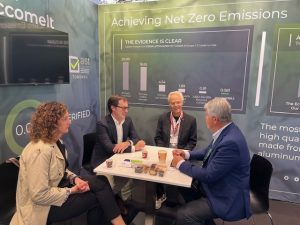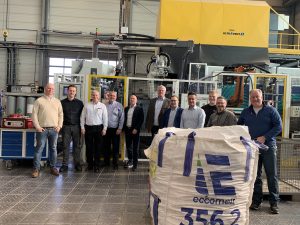Eccomelt LLC participated in last week’s Platts Aluminum Symposium in San Diego, CA, where Frank Cicchino and Martin Hartlieb met with customers, suppliers and fellow aluminum industry experts to discuss the current situation in our industry.
Here are the highlights of the presentations from this premier event:
The primary aluminum industry had another positive year in 2018, with global primary aluminum demand increasing in the range of about 3 to 4%. Most participants agreed that in 2019 there will be a further increase of 2 to 3% of primary demand (2-4% in China, and 1-3% in the rest of the world), which would be positive, but below global expected GDP growth. Volatility remains our biggest problem with various geopolitical events, trade tensions, and several other uncertainties (like Brexit). For primary aluminum production, the volatility in the alumina price, driven by unforeseen supply disruptions like the Alcoa strike and Alunorte curtailment, represented the biggest challenge in 2018. In fact, Alumina production costs overall went up in 2018 (as they had in 2017) and might continue to do so, since bauxite reserves show degrading quality, which means more than the traditionally calculated 2 tons of bauxite are required to produce 1 ton of alumina. In addition, the Chinese increased their alumina refining capacities significantly, which means they are now mainly importing bauxite and no longer alumina.
China Becomes Net Exporter of Alumina in 2018 & Fight against Illegal Production
Although bauxite shortages sometimes lead to alumina refinery curtailments, the Chinese refineries occupy mainly the upper half of the cost curve; they are more inland, which means higher transportation costs, and the Chinese bauxite market is extremely tight (imports came in 2018 mainly from Guinea and Australia). There are limited alumina capacity expansions in sight short term outside China. Other factors, like increasing caustic soda prices, worsen the cost situation for alumina production. Nevertheless, China has unexpectedly become a net exporter of alumina since about mid- 2018. China also seems to be moderating primary aluminum production/supply, but continues to be the main driver of supply growth worldwide (as it has been for the past two decades). In addition, China seriously tried enforcing announced winter curtailments and is fighting “illegal production”.
Primary Aluminum Market in Deficit in 2018
The primary aluminum market was in a deficit in 2018, which is expected to continue this year, mainly driven by a continued strong transportation segment globally, and continued European and North American demand. A moderate expansion on the supply side is expected, which will depend on happenings in China, as it represents more than half of the global demand and supply. With respect to primary aluminum production, China is expected to be almost balanced in 2019, while the rest of the world will be in the deficit zone. Global aluminum inventories are finally trending downwards toward historical levels (at least ex-China). Profitability of most smelters worldwide has come down last year, and many players are under severe cost pressure. We have seen several closures/curtailments last year, but the new smelters that are being built in China seem to have lower cash costs than the existing ones, which means that even at current prices they would be profitable (they are in low income regions with currently still better air quality).
As far as regional premiums are concerned, the US MWTP is by far the highest in the world, mainly driven by section 232 duties and continued significant metal deficit in the region. The Rusal sanctions have played an important role in the high MWTP, and uncertainty in this area continues to impact the markets. The Aluminum Association reiterated that they continue advocating for quota free exceptions from the section 232 duties for “market economy” countries to be reinstated. Most participants agreed that the duties are hurting our industry. Their potential benefits are negligible since there is limited primary capacity that could re-start, and the average smelter age in the US is over 40 years old. The negative impact of the duties affects the vast majority of companies and jobs in the downstream industries. The impact of the duties on primary VAP import volumes was mixed, and billet imports have grown in 2018 despite the duties. What was shocking for most symposium participants was that of all the granted exclusions from section 232 duties roughly 50% come from China. (The Aluminum Industry has been lobbying for actions precisely against Chinese overcapacity.)
Impact on Substitute & Secondary Aluminum Market | Recycled A356.2
The recycling and secondary aluminum market has been severely impacted by the Chinese limitations on scrap imports (specifically the “Green Fence” policy and the 50% import duty on US scrap), which left the US with large amounts of scrap that would have normally been exported to China, and for which there is simply not enough processing capacity in North America. The immediate consequences were lower scrap and secondary aluminum prices, and spreads widened to historic levels. New countries (in Asia outside of China) are now increasingly importing North American aluminum scrap, but the lost volumes from China are very difficult to replace any time soon, as building up adequate processing plants and the necessary infrastructure takes both significant investment and months, if not years, to train people to become skilled sorters. So there certainly remain opportunities for re-growth in US aluminum scrap processing and we have already seen investment announcements, but with a limited A380 market, we will need to find new ways to turn aluminum scrap back into higher value alloys/products. Some are hoping that lower metal prices will help increase re-shoring of lost die casting production volume, but most die casters are already running at full capacity and with the skilled labor shortage, re-shoring will be difficult to a large extent. Users like Reynolds consumer products reported that the reduced secondary alloy prices, combined with high primary prices due to the tariffs, are driving them to better analyze possibilities to replace primary alloys, at least in part, with certain types of scrap.
As for aluminum semis, the surplus in China and deficit ex-China continues. Net exports from China grew, even in 2018, despite the tariffs in the US. This was mainly explained by the weak Chinese currency (RMB). The biggest growth of these exports was into other Asian countries, and this expansion was the main driver for internal Chinese primary aluminum demand.
Outlook for 2019
As for the outlook for 2019, most presenters agreed that it remains positive for 2019, with continued growth in supply (3-4%) and demand (2-3%) in several sectors, especially transport. The estimated primary market balance is expected again to be negative (with China almost balanced). However, with possibly lower input costs (not all agreed with this) and potential supply increases both in China and ex-China, aluminum prices are likely not increasing. Regional premiums are expected to go down with reintroduction of Rusal metal, but most presenters and participants don’t expect the 232 tariffs to be lifted under the current administration, which will leave North America with the highest aluminum prices in the world.
About Eccomelt356.2 | Direct Substitute for A356.2 Ingot, Sow & T-bar
Alongside Alcan R&D, Eccomelt has developed a patented revolutionary process that produces a specification alloy from aluminum wheels at a lower cost than traditional methods and that meets that EPA definition of CLEAN CHARGE.
Eccomelt ships products to foundries within North America including the United States, Canada, and Mexico, and worldwide, such as France, Ireland, Italy, Serbia, and Spain. Our product is the material of choice for many consumers because it is chemically pure and environmentally-friendly. Its shredded form has achieved higher melting rates than Ingot, Sow or T-Bar. Environmental testing has also proven the process eliminates all coatings.
If you are an industry affected by the tariffs and proposed sanctions and looking for alternatives please give us a call. We can be contacted at (888) 356-9557 or visit our website and fill out our contact form.



